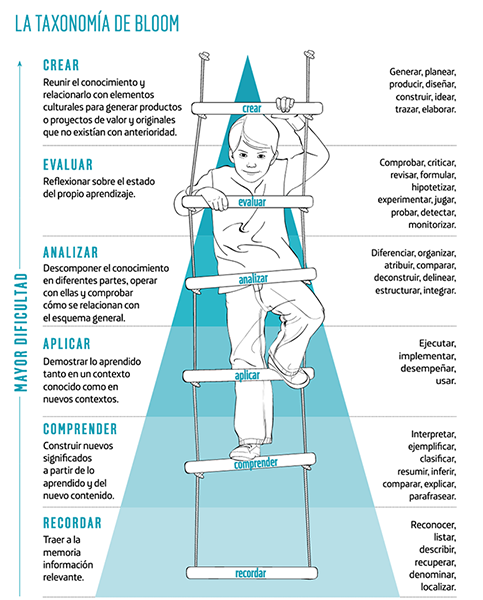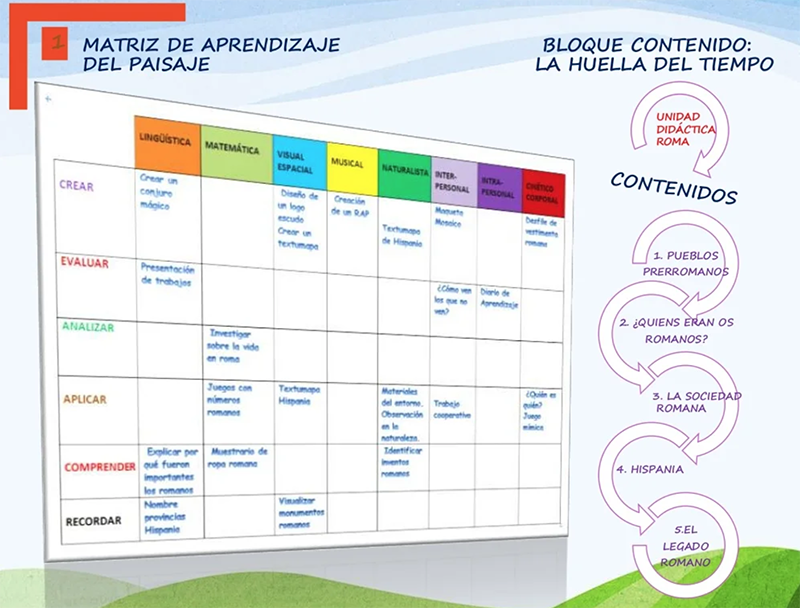Why learn the list of the Gothic kings by heart when you can have an adventure with them face to face? What if instead of memorising boring laws of physics, we embarked on a space voyage with Einstein and Newton and had them tell us about them? It is said that we only remember 10% of what we read and 20% of what we hear. However, we are still bent on boring students by reciting lessons inside the classroom. They also say that we can remember 90% of what we do. What if we change the chip and learn by doing? Learning landscapes come to the rescue.
What are Learning Landscapes?
Learning landscapes are a pedagogical tool that allows us to create personalised educational scenarios for our students by combining comprehension activities with symbolic worlds that encourage and harness the student’s imagination for learning (Inspiratics, n.d.). Through this tool, students can learn the different contents of the subjects in an interactive way, through a story created by the teacher, who proposes a series of activities and challenges to be solved.
Once planned and designed, learning landscapes would look like a web-based environment, which can be customised and to which links to websites, videos, podcasts and other resources can be added.
As we will see below, two key pedagogical models converge in learning landscapes: the theory of multiple intelligences and Bloom’s taxonomy.
On multiple intelligences and various taxonomies

Fuente: Hernando, A. (2016)cinestésica, la inteligencia intrapersonal, la inteligencia interpersonal y la inteligencia naturalista.
The theory of multiple intelligences, formulated by Harvard psychologist Howard Gardner, identifies and defines up to eight different types of intelligences needed to cope with life: logical-mathematical intelligence, spatial intelligence, musical intelligence, bodily and kinaesthetic intelligence, intrapersonal intelligence, interpersonal intelligence and naturalistic intelligence. Gardner claims that all people possess each of the eight kinds of intelligence, although each person excels more in some than in others.
Bloom’s taxonomy (also known as the taxonomy of learning domains) was designed by the American psychologist and educator Benjamin Bloom and allows for a hierarchy of cognitive processes at various levels from the most basic to the most complex. After some revisions, Bloom’s taxonomy now ranks cognitive processes, from least to most complex, as follows: remembering, understanding, applying, analysing, evaluating and creating.
Learning landscapes are, as we shall see, a cross between these two pedagogical models, although they also apply different active methodologies such as visual thinking, cooperative learning or design thinking and can be combined with methodologies such as gamification, cooperative learning, flipped classrooms or project-based learning.
Why use learning landscapes?
- It facilitates individualised attention to the student. Learning landscapes respond to the needs of learners by providing them with an audiovisual, intuitive and functional environment that captures their attention, making content more engaging, achieving greater retention of concepts and enhancing their digital skill.
- Increases motivation for learning. Learning landscapes provide an environment that combines playful elements with appropriate instructional design and activities that are both challenging and motivating for students.
- Students are the autonomous protagonists of their learning. Students learn by doing, guided by the teacher, who accompanies them on their journey of exploration and discovery. The flexibility of the learning landscapes allows each learner to use the content and solve the challenges presented to them according to the way they learn. Thus, he/she moves from being a passive subject to an active agent of his/her learning process.
- It develops the digital skill of the teacher and the learner. Learning landscapes help students acquire digital skills such as critical thinking and safe and ethical behaviour in the digital environment. For its part, it helps teachers to make a qualitative leap in the use of technologies in education, helping them to reach that desired level of appropriation in which the teacher is able to:
- Plan and integrate digital technologies into the curriculum to personalise education according to the needs of their students.
- Create digital resources to share with themselves and other teachers, and even teach their students and colleagues to do so.
How to create a learning landscape: six keys

Prieto Castillejo, R. (2018).
Creativity and imagination. These are undoubtedly two of the most important tools of learning landscapes. If pupils’ imagination and creativity are to be stimulated, teachers must also make use of these qualities. Here’s why.
Learning pathways. They are the basis of learning landscapes. The teacher should be very clear about the learning route (or routes) he/she is going to design for his/her students. These routes are made up of various activities, which may be compulsory, optional or reinforcement activities, and which will be connected to the curriculum being taught. How do we design these learning routes? Continue reading.
Programming matrix. The definitive tool that will help us to programme our activities. Do you remember multiple intelligences and Bloom’s taxonomy? These are the axes of this matrix or table, on the top of which we will place the eight intelligences and on the left side of which we will include the six levels of the taxonomy. This will result in a document with 48 boxes where each of the intelligences converge with the taxonomies. The intelligences guide the style of activity and Bloom will direct the focus of these. These boxes will help the teacher to design the activities he/she wants the students to do, which may have different depths and levels of difficulty. And, as mentioned above, these activities will be compulsory, optional or reinforcement activities.
Narrative. Now comes the fun part. All this has to fit into a setting, into a story. A narrative must be invented to give coherence to the whole. Storytelling, as they call it nowadays. A story capable of moving and motivating students. That is: the learning landscape itself. It can be a time adventure that takes us back to a period of history that we want to teach. Or a space voyage that teaches us some physics fundamentals. Or a Jumanji-type adventure to learn science. Or a mind-blowing journey aboard a microscopic ship through the human body (like the film) to learn biology. Anything. As you can see, the limit is set by the students’ interests and your imagination. Fun, right? Well, it’s not over yet.
Gamification. This is optional but recommended. Challenges and games always increase motivation. Badges, points tables, challenges… The aim is to gamify the narrative through characters, challenges, plots… which will also serve to evaluate the activity and the knowledge acquired.
Digitalisation. Once we are clear about our learning paths, activities and story, we will proceed to create our interactive virtual environment: we will select the main image and all the images that should be part of the story, the icons, the videos, the sounds… we build our interactive image and insert all the elements into it. Of course, there are applications, such as Genia.ly that help you do this in a guided and convenient way.
Human beings are different and learn differently. When educational models and curricula do not take into account this principle of diversity and are designed only with the average in mind, they are failing society (Escuelas Católicas, n.d.). Let us design experiences that take differences into account and integrate them so that everyone can access education fairly and equitably.
If you want to learn more about this educational tool, here you have a very complete guide with video tutorials and articles explaining how to put them into practice in the classroom. There are also intensive training courses such as the one offered by our Programme Units – ProFuturo.
REFERENCES
Escuelas Católicas. (n.d.) paisajesdeaprendizaje.com. Web page. Accessed 1 June 2022. http://paisajesdeaprendizaje.com/
González del Hierro, M. (n.d.). Paisajes de aprendizaje: una potente herramienta educativa. Genial.ly Blog. Accessed 1 June 2022 https://blog.genial.ly/en/learning-landscapes/
Inspiratics. (n.d.). Paisajes de aprendizaje. Qué con y cómo implementarlos en clase. Web page. Accessed 30 May 2022. https://inspiratics.org/es/recursos-educativos/recursos/paisajes-de-aprendizaje-qu%C3%A9-son-y-c%C3%B3mo-se-aplican/






